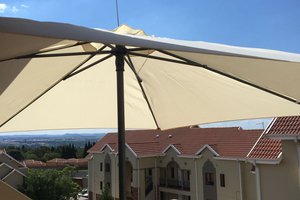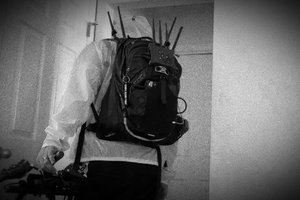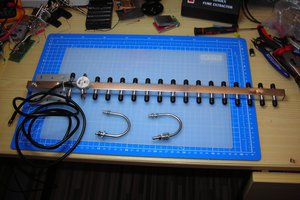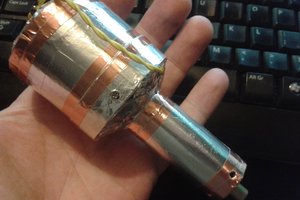So, you have a router and not an antenna. Not to fear, there is a 2 cent solution. A piece of wire. There is one criteria. The conductor has to fit snugly in the center conductor hole in the connector that the WiFi antenna used to plug into. Look through your collection and don't forget things like coathangers can be filed down to fit in the hole.
The length of the wire is important. There are some physics involved here but they are pretty simple. The key formula is:
c / f = λ
Most 5 year olds remember E = mc2
Most high school kids will remember that the c in that equation is the speed of light. That is 299,792,458 meters per second in a vacuum. Most of us don't live in a vacuum and that is a lot of digits to remember so most of use round that up a bit to an even 300,000,000 which is close enough for our wifi antenna work.
The f stands for frequency. In our case in the US we have 11 channels as follows:
1 2412 Mhz
2 2417 Mhz
3 2422 Mhz
4 2427 Mhz
5 2432 Mhz
6 2437 Mhz
7 2442 Mhz
8 2447 Mhz
9 2452 Mhz
10 2457 Mhz
11 2462 Mhz
The average of these is 2437 in case you are interested. For me, I just used 2400 cause it is easier to remember.
And the last one, the lambda, λ is the wavelength. This is physically how long the wave is, like if you were to measure it with a ruler. If you have ever heard the ham radio guys talking about working in something like the "40 meter band" you can bend this formula around and discover they are working on frequencies in the range of 7500000 Hz or 7.5 Mhz.
In our case we have 300,000,000 / 2,400,000,000 = 0.125
The 0.125 answer is in meters. So the answer is 12.5cm or 125mm, but we are not home yet. The antenna wants to be a half wave. The reason is (roughly) the ground will be the other half wave. So the length of our wire wants to be 6.25 cm, but don't cut your wire just yet! We need to make it a bit longer so there will be a stub that fits in the female part of the connector. This little stub does not count in the length.
If you are using insulated wire, strip a bit to go into the connector, and measure from the end of where you stripped it. If you are using uninsulated wire you may want to use a sharpie to denote how far to stick the wire in the hole so the correct amount is sticking out.
You can bend the wire at a right angle if you like so they stick up like more traditional wifi antennas. If you are using uninsulated wire be careful that it does not short into the grounded part of the connector.
Believe it or not, this is all that is inside of one of the fancier looking wifi antennas that comes with a typical router.
I built these for an emergency. My old and reliable 15 year old wireless router started to die. The radio in it would quit after a while. Turning it off and letting it sit for an hour would cure it, but a couple hours later the radio would die again. I had another router that I rescued but it had no antennas and my old router only had internal antennas. So, I built a pair of these wire stubs and found a power cube and vola, I was back on the air.
A totally non scientific study shows that I get wifi in every room in the house, and I now get a better wifi signal in the bedroom in the far corner. Occasionally if you were listening to pandora it would stutter to a stop. Slightly moving that tablet would perk it back up again. Kind of a pain in the ass having it crap out every time you roll over going to bed at night. Now I have a rock solid signal in there....
Read more » matthewkleinmann
matthewkleinmann


 Colin Alston
Colin Alston
 Magic Robots
Magic Robots

 Morning.Star
Morning.Star
Pretty sure a vertical antenna should be a quarter-wave, not a half-wave.